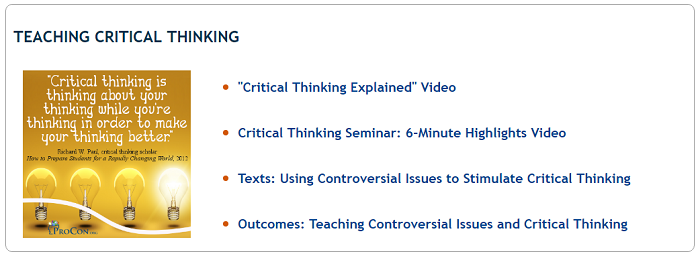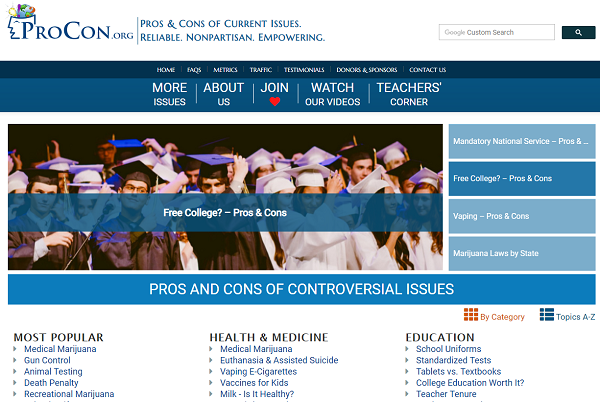- MN ABE Connect
- Archive
- Addressing the Critical Need for Critical Thinking Skills
 June 13, 2016
June 13, 2016
Addressing the Critical Need for Critical Thinking Skills
Stephanie Sommers, ACES CoordinatorWhen asked which category of the ACES Transitions Integration Framework (TIF) they would like more resources and training for in the 2016 statewide PD Survey, the greatest number of respondents (48%) chose Critical Thinking. This makes sense, as educators and employers alike consistently list critical thinking as one of the most important skills that a person should possess.
 While thinking about tools that I have used to develop critical thinking skills with adult learners, I re-visited one of my favorite websites: ProCon.org. In the past, I have used ProCon.org primarily to gather background or source reading material for activities like conducting a classroom debate or helping students prepare for writing a persuasive or argument essay. When I recently visited the website, however, I noticed a feature I had never zeroed in on before called the Teacher’s Corner. I’ll get to some more specifics on that right after some general information about ProCon.org, which has been added to the Critical Thinking category of the ACES resource library.
While thinking about tools that I have used to develop critical thinking skills with adult learners, I re-visited one of my favorite websites: ProCon.org. In the past, I have used ProCon.org primarily to gather background or source reading material for activities like conducting a classroom debate or helping students prepare for writing a persuasive or argument essay. When I recently visited the website, however, I noticed a feature I had never zeroed in on before called the Teacher’s Corner. I’ll get to some more specifics on that right after some general information about ProCon.org, which has been added to the Critical Thinking category of the ACES resource library.
What is ProCon.org?
According to their website, ProCon.org is a nonprofit and nonpartisan organization devoted, in part, to promoting critical thinking. They carry out this mission by providing research on more than 50 controversial issues that help students learn how to question information, evaluate opposing views, and debate important topics. There is no registration or fee required for using the website, and the topics can be viewed by category, such as education, science and technology and health and medicine, or alphabetically by topic. They have even created an entire section devoted to information about the 2016 presidential election.
The information for most of the controversial topics begins with a general overview that explains the core question; followed by some Did you know? facts about the topic; followed by a list of points divided by pro and con; and ends with a background reading. There is also a video gallery for some of the topics with videos that are labeled pro, con, or “not clearly pro or con.” Perhaps because ProCon.org has a large audience that extends beyond teachers and students, the reading level can be challenging. It is probably most appropriate for High Intermediate and Advanced ELL learners on up.

Teacher’s Corner
The Teacher’s Corner (on the far right side of the menu) provides lesson planning tools and lesson ideas for using ProCon.org. Some of the lessons support Common Core, which in turn should support development of CCRS skills. The focus areas are English/Language Arts (ELA) and Social Studies.
The lessons that I looked at begin around a 5th grade level and go up through 12th grade. One that caught my eye has to do with recognizing cause and effect in a persuasive speech. Students watch videos from the ProCon website and complete a cause and effect map graphic organizer. They listen and take notes on first the causes and then the effects that are mentioned in the video. One thing I liked about these lessons is that they contain adaptation ideas for making the lessons easier or harder. This seems like a great tool for teachers in multi-level classrooms who need to differentiate instruction.
Another promising lesson focuses on identifying the main idea of visual resources. For this lesson, students examine the charts, infographics, political cartoons, and other visual resources included with a topic and create a one-sentence “take away” statement. The Teacher’s Corner also has an entire section devoted to teaching critical thinking and another one that contains a compilation of over 70 illustrated quotes about critical thinking from famous thinkers like Howard Zinn and Albert Einstein.
I will close with a quote by Confucius: “Learning without thought is labor lost; thought without learning is perilous.”
Newsletter Signup
Get MN ABE Connect—the official source for ABE events, activities, and resources!
Sign UpArticle Categories
- ABE Foundations/Staff Onboarding
- ACES/Transitions
- Adult Career Pathways
- Assessment
- CCR Standards
- Citizenship
- COVID-19
- Cultural Competency
- Digital Literacy/Northstar
- Disabilities
- Distance Learning/Education
- ELA
- Equity/Inclusion
- ESL
- HSE/Adult Diploma
- Listening
- Math/Numeracy
- Mental Health
- Minnesota ABE
- One-Room Schoolhouse/Multilevel
- Professional Development
- Program Management
- Reading
- Remote Instruction
- Science
- Social Studies
- Speaking/Conversation
- Support Services
- Teaching Strategies
- Technology
- Uncategorized
- Volunteers/Tutors
- Writing